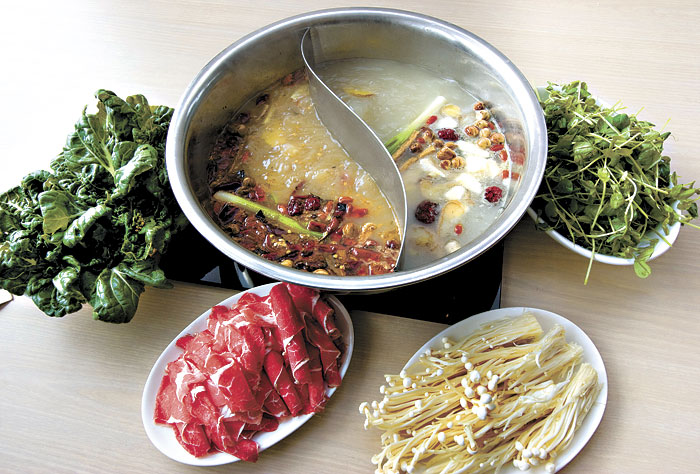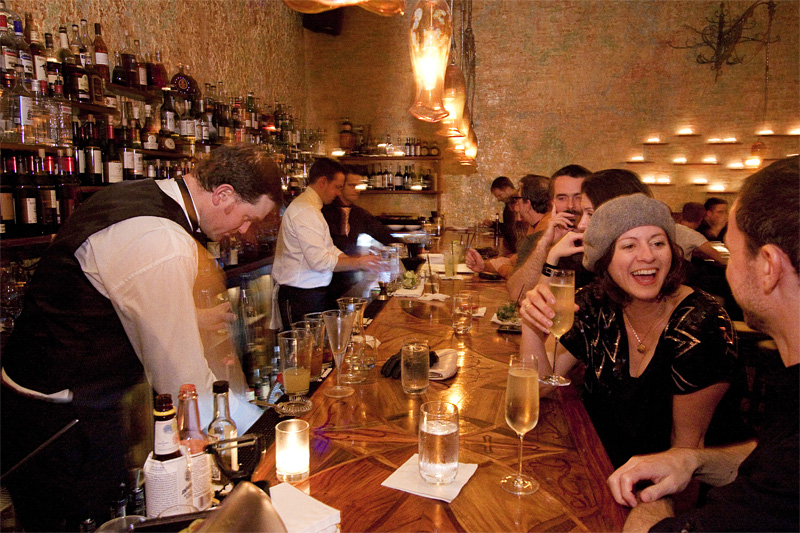A few years back, when a pair of University of Nebraska researchers made national news by proving that one of their Jewish grandmother’s recipes for chicken soup reduced inflammation and broke up congestion, readers with Chinese grandmothers must have smirked into their monitors. Chicken, celery, onions, carrots—that’s primitive medicine compared to the herb-packed hot pots that generations of Asian old ladies have brewed up to bolster health and stave off colds.
At Little Hot Pot in Bellevue, the aroma of the steaming pots around the room—resiny, tingly, alchemical—encircled us the moment we entered, and only intensified when the waitress brought our own stainless tub of broth, set it on the square black induction heater, and set the contents a-bubbling. We asked the manager to identify some of the herbs floating on the surface. A mummy’s pinkie turned out to be pilose asiabell, which she said was good for breathing, provided it was cooked with astragalus (those were the white sections of tongue depressor). The rounds that looked like dried figs were actually longans, and the bright red ovals were wolfberries (currently a fashionable ingredient in energy bars under their alias, “goji berries”). Pointing more vaguely at the bowl, the manager racked her brain to remember the English words for cumin and angelica—and all this was just to index the mild broth. “The spicy broth has our secret blend of more than 36 herbs,” she said. “It simmers all day.”
You doubters can pooh-pooh the health effects of Little Hot Pot’s herbal soups, patting your tube of Airborne or packet of Tylenol PM. I took two groups of people to the Bellevue strip-mall restaurant this month, and we all ended the meal overfed and thrilled. Health, schmealth: These broths are good.
Little Hot Pot, which opened a couple of months ago in a strip mall on the edge of Crossroads, is actually Washington’s first Little Fat Sheep branch (or sometimes Little Sheep, depending on the translation of the Chinese name Xiao Fei Yang). Normally identified by a snuggly, bow-tied ram logo, the 10-year-old chain, based in the Inner Mongolia region of China, has more than 350 restaurants and franchises in Asia and North America.
The impression the restaurant makes, decor-wise, is of well-scrubbed surfaces with hints of opulence—tiled floors, plain wood tables, waist-high panels of black granite on the walls. The bar resembles one of Mondrian’s boogie paintings wrought in magenta, jade, and saffron. Torches with fabric flames, rustic herding tools, and oversized earrings on the walls bespeak Little Hot Pot’s mythic origins in Mongolian army campfires.
Ordering at Little Hot Pot turns out to be like taking the Scientology personality quiz—only you’re given stir-fried peanuts and pickled radish while you check off boxes, instead of creepy smiles and Dianetics books. First you select the broth: mild, spicy, or half-and-half. Then you look over the cold plates, smoothies, and side dishes. (These are largely superfluous—though the translucent, papery slices of pig’s ear dressed in a tingly red oil were worth a crunch, and the stir-fried noodles with beef and greens kept our 10-year-old guest content.) Finally, you haggle over which of the 70-some ingredients, priced from $2.50 (vegetables) to $5 (meat and seafood), you want to cook.
Our table was soon crowded with platters: Baby bok choi no bigger than half-opened roses. A heap of pea-shoot tips. Clumps of spindly white enoki mushrooms. Thick slices of lotus root, which with their network of holes looked like a Girl Scout turnip-carving activity. Feathery chrysanthemum greens (“tong ho” on the menu). Thick, clear noodles that uncooked looked like plastic rulers and which boiled into stretchy, jiggly lengths. And, of course, three meats: triangular chunks of puffy white pork stomach, crimson rolls of sliced frozen beef, and glistening baby cuttlefish the size of tiny Post-It notes.
In the center of the table simmered our yin-yang pot, a bisected bowl with two different broths. On one side was the clean, milky “mild” broth, which smelled like a cross between my old acupuncturist’s office and a spice drawer; its delicate meatiness was tinged with the sugar from a handful of dried dates and longans. The other side, meanwhile, was deliciously, dangerously coated in a few millimeters of red oil, and wilder smells—cinnamon, chiles, cumin, galangal—wafted up from its surface.
As soon as the broths came to a soft boil, we shoveled in ingredients, using a ladle to scoop out broth and a pair of pasta forks to pluck out the cooked bits. According to the menu, things from the sea should cook for two minutes, things from the land for four minutes, and vegetables five minutes. These general rules were helpful but inexact. For example, the steak was shaved so fine that it took 60 seconds to go from frozen to brown, and the cuttlefish were spectacular at one minute and rubbery at three. On the other end of the spectrum, the lotus root only softened up around the 10-minute mark, and the pork stomach was chewy after five minutes and exquisitely tender after 20. But the meal quickly settled into a rhythm—feed the pot, stir the pot, pluck from the pot, feed it again—and somehow four people, scooping and passing, let very little overcook.
I’ve eaten dozens of hot pots—sweet-sour Vietnamese lau with eel and banana blossoms, Northern China’s lamb hot pot with sesame-paste dipping sauce, Taiwanese hot pots with watery chicken stock and mix-your-own-sauce buffets—and Little Hot Pot’s broths entranced me with the way they enveloped everything that cooked in them in shifting fields of scent. Pea sprouts that had barely had time to wilt down in the mild broth tasted as if they had braised for an hour, and as the broth rolled and steamed, absorbing the flavors of everything in it, its potency only increased.
One cautionary note: We assumed the heat scale for the spicy broth was calibrated to Seattle palates and ordered an 8 (out of 10). This was a mistake. I was prepared that the chiles might make my face resemble a pyrotechnic Bozo the Flaming Clown, but this was more akin to sipping pepper spray, which coated the back of my throat in pain. Each spoonful was like taking a bong hit—my friends and I kept doubling over, racked by sputtering coughs, and finally had to cave in and ask for ice water. “The spicy broth is actually better for you because it has more herbs,” the manager helpfully told us after we’d asked for extra napkins to wipe away the sweat. “In fact, it’s spicy but it won’t upset your stomach.” (Um, my stomach was fine. I’ll spare you the details from the next day.)
I returned a week later: different friends, same effect. At three ingredients per person (and a total cost of $20 apiece), we left nothing on the table. And the spicy broth, at a spice level of 3, still lashed my throat but left me able to breathe. This time, we let tea-tree mushrooms simmer until they softened, their piney aroma emerging after the long braise just as the orange flesh of kabocha squash turned custardy-sweet. The broth wilted frozen curls of lamb, tamed the bite of watercress, tinged the floppy crunch of wood-ear mushrooms with its perfume, and saturated every air pocket of spongy frozen tofu. Sure, winter’s last cold slammed my sinuses the week afterward. But at the end of that night, spice-ruddied and steam-bathed, I felt I could have taken on the ebola virus and emerged unscathed.
Price CheckBroth (per person): $3.50Bok choi: $2.50Wood-ear mushrooms: $3.75Wide clear noodles: $3Frozen tofu: $2.50Lamb: $5.25Baby cuttlefish: $4.50






